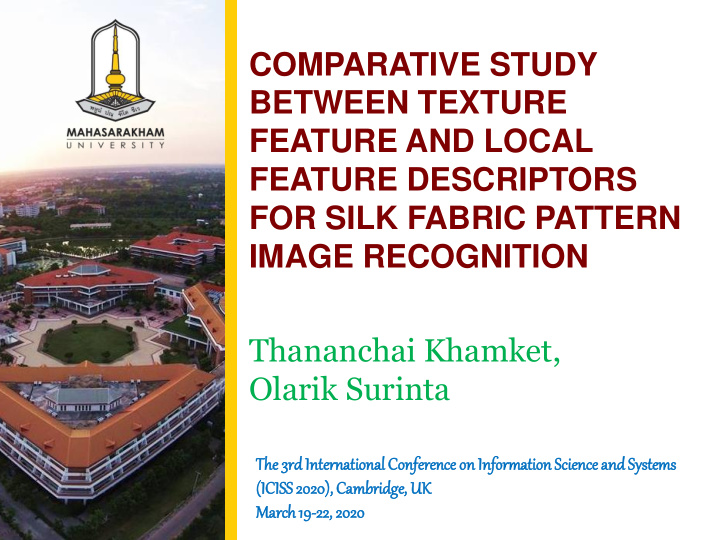



COMPARATIVE STUDY BETWEEN TEXTURE FEATURE AND LOCAL FEATURE DESCRIPTORS FOR SILK FABRIC PATTERN IMAGE RECOGNITION Thananchai Khamket, Olarik Surinta The e 3rd rd Inte Internati tional Con onference on on Inf Informati tion Sc Scie ience and and Sys Syste tems (IC ICISS 2020 2020), , Cambridge, , UK March 19 19-22 22, , 2020 2020
Outline Contributions Silk Fabric Pattern Image Recognition Methods Texture Feature DIVIDER SLIDE Local Feature Descriptors Section title Classification Algorithms The Silk Fabric Pattern Image Dataset Experimental Settings and Results Conclusion 2
Contributions We proposed to use two well-known local gradient feature descriptors ● Histogram of Oriented Gradients (HOG) ● Scale-Invariant Feature Transform (SIFT) The gradient feature descriptors combined with the Support Vector Machine (SVM) and the K-Nearest Neighbors Algorithm 3
Silk Fabric Pattern Image Recognition Methods In this research. first , we propose a grid- based method, which has been successful in many areas, such as face recognition, people tracking , and fast image retrieval, for diving the fabric silk image into small regions. Second , we compare two well-known feature extraction techniques: the texture feature and local feature descriptor due to the study of the robustness and effectiveness. Each feature extraction technique is proposed to calculate a feature from a small region. 4
Silk Fabric Pattern Image Recognition Methods Third, we concatenate the features from each region and use them as the robust feature vector. Finally , two classifiers called the K-nearest neighbor (KNN) and the support vector machine (SVM) methods are used to create a model and classification process. 5
Figure 1. Method of computing the local binary pattern feature from the silk pattern image. 6
The Silk Fabric Pattern Image Dataset The Silk-Pattern dataset was collected from a silk shop in Maha Sarakham, located in the northeast of Thailand. Illustration of the a) Thai silk fabric, b) main pattern and c) fabric feet. 7
The Silk Fabric Pattern Image Dataset The Silk-pattern dataset consists of ten Thai silk pattern classes and contains 300 images captured using a smartphone The Silk-Pattern images are stored in the RGB color space with a size of 450x650 pixels 8
The Silk Fabric Pattern Image Dataset In the Silk-Pattern dataset, the test set is randomly cropped only 30% and 40% from the whole silk fabric pattern image. 9
The Silk-Diff-Pattern dataset In addition, we introduce a new dataset of Thai silk pattern images, which is more complex and challenging, called the Silk-Diff- Pattern dataset. The advantage of our new dataset is that the silk pattern images include all components of the silk pattern; pattern and fabric feet. Examples of the Silk-Diff-Pattern dataset are shown in Figure 5. Our dataset also has 10 classes and contains 300 images. 10
Figure 5. Illustration of the training set of the Silk-Diff-Pattern dataset. 11
Experimental Settings and Results To provide data for the silk fabric image recognition, we used two silk datasets; the Silk-Pattern and the Silk-Diff-Pattern datasets. The experimental results are based on 5-fold cross-validation. We compute average recognition accuracies and standard deviations for all experiments. Also, the grid-based method is performed. 12
Experimental Settings and Results Table 1. Evaluation of the classification results on the Silk-Pattern dataset. Accuracy Result Method Crop-30 Crop-40 93.48 ± 𝟏 .64 LBP+KNN 99.26 ± 0.79 HOG+KNN[19] 92.05 ± 0.31 89.73 ± 0.33 SIFT+KNN 23.03 ± 0.36 57.99 ± 0.33 LBP+SVM 92.61 ± 0.16 98.46 ± 0.08 HOG+SVM 74.92 ± 1.94 82.68 ± 4.67 SIFT+SVM 42.80 ± 6.98 40.24 ± 1.08 LeNet[19] 64.06 ± 2.25 76.98 ± 2.29 AlexNet 44.70 ± 0.94 55.58 ± 1.04 13
Experimental Settings and Results Table 2. Evaluation of the classification results on the Silk- Diff-Pattern dataset. Accuracy Result Method Crop-30 Crop-40 65.70 ± 0.84 79.20 ± 0.45 LBP+KNN 76.58 ± 0.98 88.45 ± 0.23 HOG+KNN 49.59 ± 0.99 59.44 ± 1.14 SIFT+KNN 90.97 ± 𝟏 .74 92.81 ± 𝟏 . 𝟖𝟓 LBP+SVM 48.18 ± 1.55 73.22 ± 0.95 HOG+SVM 41.40 ± 0.94 34.58 ± 1.04 SIFT+SVM 14
Conclusion First, we proposed a grid-based method for dividing the image into sub-areas. Second, the two well-known feature extraction techniques: texture feature and local feature descriptor, were proposed to extract robust features from sub-area. The grid-based method allowed the feature extraction technique to extract more useful features 15
Conclusion Finally, we concatenated the robust features and fed them to the classifier algorithms: K- nearest neighbor and the support vector machine algorithms. 16
Future work In future work, we want to study deep learning architecture and apply it to the silk image dataset. We are also interested to improve the performance by using transfer learning and data augmentation. 17
THANK YOU FOR YOUR ATTENTION
Recommend
More recommend